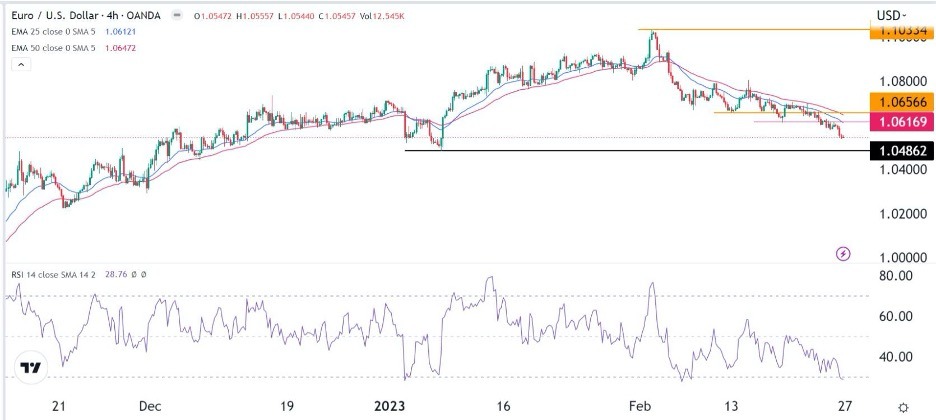Bearish view
Bullish view
- Set a buy-stop at 1.0570 and a take-profit at 1.0700.
- Add a stop-loss at 1.0500.
The EUR/USD exchange rate continued plunging after the red-hot American consumer inflation that pushed the dollar index to the highest point in two months. It plunged to a low of 1.0545, the lowest point since January 6. The pair has plunged by more than 4.50% from its highest level this month.
US and Europe inflation is stubbornly high
Data published last week showed that US and European inflation remained stubbornly high in January. In Europe, the main concern is that core inflation, which excludes volatile products like natural gas, remained at the highest point in years.
As a result, with the bloc’s economy growing at a slower pace, analysts believe that the ECB has more room to hike interest rates in the coming months. Analysts have penciled in another 0.50% rate increase in March followed by several small increases.
Meanwhile, the US published the personal consumption expenditure (PCE) data on Friday. The numbers showed that the PCE rose by 5.4% in January while the core CPI rose by 4.7%. Therefore, some analysts, including Mohammed El Erian are questioning whether the Fed will be able to bring inflation to its inflation target of 2.0%.
The EUR/USD will have some key catalysts this week. In the US, the Conference Board will publish the latest consumer confidence data. These are important numbers because they are good indicators of consumer spending, the biggest part of the American GDP.
The other important economic numbers to watch from the US will be the ISM manufacturing and non-manufacturing PMI numbers. These are crucial figures since they are good indicators of the health of the American economy.
The European Union will also publish other important economic numbers. On Thursday, Eurostat will publish the flash consumer inflation data. Analysts expect that the bloc’s headline inflation dropped from 8.6% to 8.2% in February.
EUR/USD forecast
The EUR/USD exchange rate continued its bearish trend after the strong inflation data. It moved to a low of 1.0542, the lowest point since January. As it dropped, it moved below the key support at 1.0616, the lowest point on February 17. It has moved below the 25-day and 50-day moving averages. It also dropped below the Ichimoku cloud while the Relative Strength Index (RSI) has moved below the oversold level.
The pair will likely continue falling as sellers target the next support at 1.0486, the lowest point on January 6.
Ready to trade our daily Forex signals? Here’s a list of the top Forex brokers worth reviewing.
